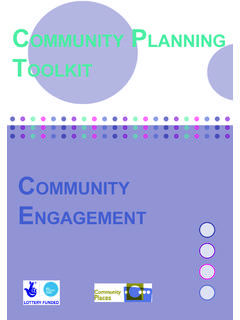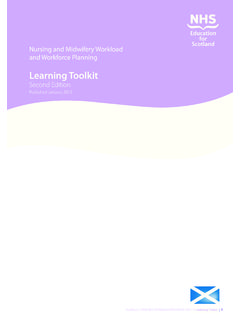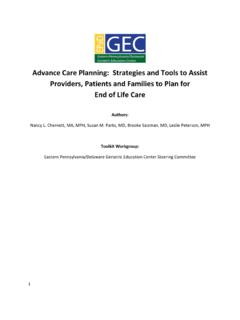Transcription of Ready for Printer Departure Defined Toolkit - May …
1 ETI: Departure Defined Transition Toolkit Welcome .. Ask any nonprofit executive about the work they do and you will mostly hear a resounding affirmation for their career choice. Indeed, leadership in the non-profit sector is among the most rewarding and challenging professional experiences. Unfortunately, even the most gratifying experiences must eventually come The Executive Transition to an end. Initiative would like to thank the Nonprofit If you are reading this, chances are that you are an executive who is Management Fund for approaching, or has already reached, a professional milestone in your life. funding the development Perhaps you are just beginning to think about leaving your nonprofit of this Toolkit . We are organization. Or maybe you've already decided that the time for change is grateful for your approaching rapidly. If you are a nonprofit board member reading this, commitment to sustaining perhaps your founding executive has just informed you that he or she plans excellence in nonprofit to leave the organization and you are just beginning the planning process.
2 Leadership in Milwaukee! Whatever your role, the good news is this: your nonprofit organization will not only survive following a leadership transition, it will thrive. All success requires is thoughtful planning . Departure Defined transitions are anticipated departures, usually expected to occur within one to eighteen months. Departure Defined transitions commence when an executive begins thinking about leaving and begins to explore alternative opportunities. planning activities include communicating the transition to the board, staff and community stakeholders, conducting an organizational assessment, building organizational capacity and sustainability, recruiting and hiring a new executive, and celebrating the leadership succession. The purpose of this Departure Defined executive transition Toolkit is to provide you with a roadmap through the executive transition process in your organization. It provides step-by-step strategies for Executive Directors and board members, and useful tools that can be used to implement a Departure Defined transition.
3 It is important to recognize that every organization has its own unique leaders, culture and needs. Therefore, we encourage you to use the information that best suits your organization, and to adapt the tools to address your specific organizational culture. We have done our best to summarize the current best practices, and provide find links to articles and information on emergency transition planning available on the web. We welcome your feedback on the Departure Defined executive transition Toolkit . Whether your executive transition is on the horizon or just around the corner, we hope you will avail yourself of all the resources available. The Executive Transition Initiative, these toolkits and the accompanying resources will support your efforts to sustain and strengthen your organization. Mindy Lubar Price ETI Project Manager 1. ETI: Departure Defined Transition Toolkit Acknowledgements: This Toolkit would not have been possible without the insight and feedback of many nonprofit leaders who have shared their ideas, their experiences and even their personal stories in the spirit of contributing to the body of knowledge about nonprofit succession planning .
4 We would also like to thank the following foundations for their insight and commitment to developing leadership capacity in nonprofit organizations: the Brico Fund, LLC, for their early and ongoing leadership in raising awareness about the need for executive transition management; The Bob & Linda Davis Family Foundation for supporting the development of the Emergency Succession planning Toolkit , and the Nonprofit Management Fund in Milwaukee Wisconsin for supporting the development of the Departure Defined Toolkit and for their commitment to supporting local nonprofits who are committed to succession planning in their organizations. Also to the Annie E. Casey Foundation for supporting the evolution of executive transition management in the nonprofit sector. We would also be remiss if we did not acknowledge the Center for Urban Initiatives and Research at the University of Wisconsin Milwaukee for their contribution to the 2004 survey about the leadership landscape in Milwaukee that raised awareness about the important need for nonprofit succession planning in our community.
5 We would also like to thank the Donor's Forum of Wisconsin for its early stewardship in the development of the Executive Transition Initiative and the Greater Milwaukee Foundation for its commitment to expanding the visibility and reach of the initiative to nonprofit organizations. We would especially like to recognize Tim Wolfred at CompassPoint Nonprofit Services for his stewardship in the development of ETI in Milwaukee, for his support and consultation in the development of this Toolkit , and for his permission to use many of the tools he developed. We would also like to recognize Tom Adams at TransitionGuides and his colleagues for permission to use their work in the development of this Toolkit and for their ongoing commitment to increasing our knowledge about best practices in executive succession planning . ETI would also like to acknowledge the contribution of Mindy Lubar Price from Leading Transitions, LLC for contribution and leadership in raising awareness about the need for nonprofit succession planning and to Tom Cooper from Write/Ideas for the creation of the overview and succession planning toolkits.
6 2. ETI: Departure Defined Transition Toolkit Contents of the Departure Defined Executive Transition planning Toolkit : In this Toolkit , you will find: An Overview of Succession planning and Departure Defined Transition planning Understanding and Managing Change 10 Strategies for Implementing a Departure Defined Executive Transition 1. Create Good Endings and New Beginnings: A Shared Responsibility 2. Engage the Board: The Board's Role in Executive Transitions 3. Explore Hiring a Transition Consultant 4. Establish a Leadership Succession Team 5. Communicate the Leadership Transition to Stakeholders 6. Conduct an Organizational Assessment To Uncover Strengths and Vulnerabilities 7. Use a Strategic Plan to Assess Future Leadership Needs 8. Translate the Assessment into a Leadership Succession Plan 9. Conduct an Executive Search 10. Announce and Celebrate the Leadership Succession Special Considerations for Founding/Long-Term Director Transitions Frequently Asked Questions about Departure Defined Transitions Resources and Citations Exhibits 3.
7 ETI: Departure Defined Transition Toolkit Overview of Departure Succession planning When you think about succession planning , you might imagine some nebulous Leadership process that happens in board rooms of big corporations. In the for profit world, succession planning succession planning has traditionally focused on grooming a successor or heir is an ongoing apparent. Succession planning in the nonprofit world is a different matter. practice based on defining an It is no surprise that most nonprofit organizations do not have a succession plan in organization's place. Small and medium size nonprofits have as many reasons for this gap as strategic vision, they have constituents. In nonprofits, planning for organizational health and identifying the sustainability often takes a back seat to efforts to serving your constituents or leadership and influencing social change. managerial skills necessary to carry It's time for nonprofit organizations to change that dynamic. out that vision, and recruiting, The Case for Succession planning : In the fall of 2004, 1,080 nonprofit developing and Executive Directors in Milwaukee, Waukesha, Washington and Ozaukee counties retaining talented were surveyed in order to gather information about the potential scope and impact individuals who of executive leadership turnover over the next five to ten years, and to inform the have or who can further development of strategies to address the pending shift in leaders.
8 Over 350 develop those skills. nonprofit Executive Directors responded to the survey. As part of the first national study of leadership transition in the nonprofit sector, the Milwaukee area survey was one of 24 conducted nationwide. The local study was sponsored by the Greater Milwaukee Foundation, in cooperation with Donors Forum of Wisconsin, Center for Urban Initiatives and Research, the Helen Bader Institute for Nonprofit Management, and the University of Wisconsin Milwaukee, in collaboration with the Annie E. Casey Foundation. Results from the survey highlighted the need to address leadership transition issues among nonprofits. Specifically: 66% of nonprofit organizations surveyed were likely to experience an executive transition within the next five years, and 26% of those in the next two years. However, of those surveyed, only 1 - 2%. reported having a succession plan in place. Organizations that had founding Executive Directors were even less likely to have a plan in place.
9 In addition, most organizations surveyed approach executive change from a search and hire framework as opposed to a more comprehensive transition management approach that emphasizes thoughtful succession planning . 55% of the current nonprofit executives were over 50 years old. 84% of responding executives were white, 11% African American and Hispanic/Latino. Only 33% of responding organizations had a deputy director. What is Succession planning ? Leadership succession planning is an ongoing practice that is focused on defining an organization's strategic vision, identifying the leadership and managerial skills necessary to carry out that vision, and recruiting, developing and retaining talented individuals who have or who can develop those skills. Ideally, leadership succession planning will include the following components: 4. ETI: Departure Defined Transition Toolkit Emergency Succession planning A thoughtfully prepared plan to address an unanticipated Departure of an Executive Director, usually occurring with only a few days or weeks notice.
10 Emergency succession plans ensures the uninterrupted performance of essential executive functions by outlining steps for the temporary appointment of an acting Executive Director. Strategic Leadership planning An ongoing process that identifies the core competencies, skills and knowledge needed by your organization in the next five years along with a plan to develop those competencies in your existing talent or recruit new talent from outside the organization. Departure Defined Transition planning A course of action that board members and Executive Directors can employ when an executive begins thinking about leaving an organization. Departure Defined transition planning focuses on communicating the transition to staff and stakeholders, conducting an organizational assessment, building organizational capacity and sustainability, recruiting and hiring a new executive, and celebrating the transition. It is important to note that each component of the succession planning process informs the others.








